Abstract
Because so little is known about the pathogenesis of recurrent bacterial vaginosis (BV), a longitudinal microbiological study was conducted on 13 women with recurrent BV treated sequentially with conventional metronidazole therapy. A rapid clinical response characterized by disappearance of mal odor and an improvement in vaginal discharge occurred in 92% of 31 clinical episodes of BV, with patients no longer satisfying the composite clinical criteria for the diagnosis of BV. However, prospective evaluation of these asymptomatic women revealed profound residual biochemical and microbial abnormalities which were best evident on Gram stain and wet mount examination of vaginal secretions. Other common residual abnormalities included mild persistent elevation of vaginal pH and polyamine and fatty acid levels and the presence of clue cells in small numbers. Residual abnormalities could be quantified to create an overall symptom code which predicted recurrence, and it was found that the severity of residual abnormalities was inversely related to the time required until the next recurrence occurred. The severity and prevalence of residual abnormalities following clinically successful therapy support the concept that BV recurrence, especially when it is early, represents a relapse rather than a reinfection. This concept may have important therapeutic implications.
Full text
PDF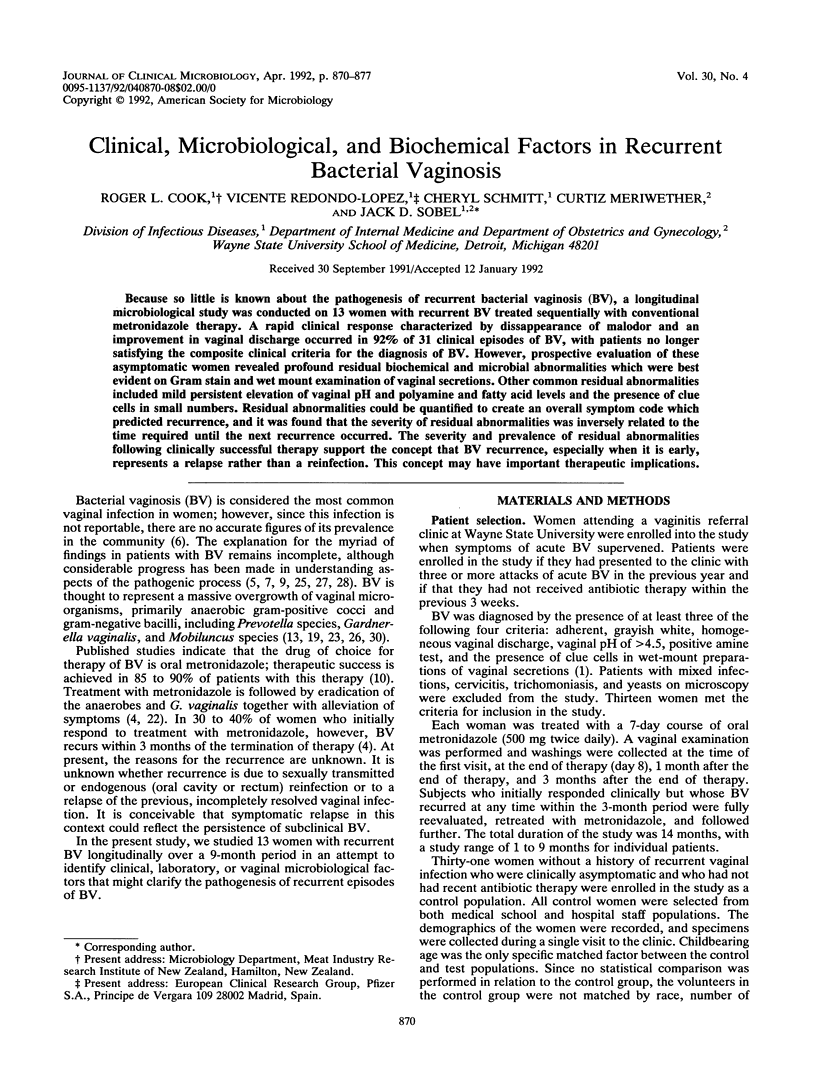
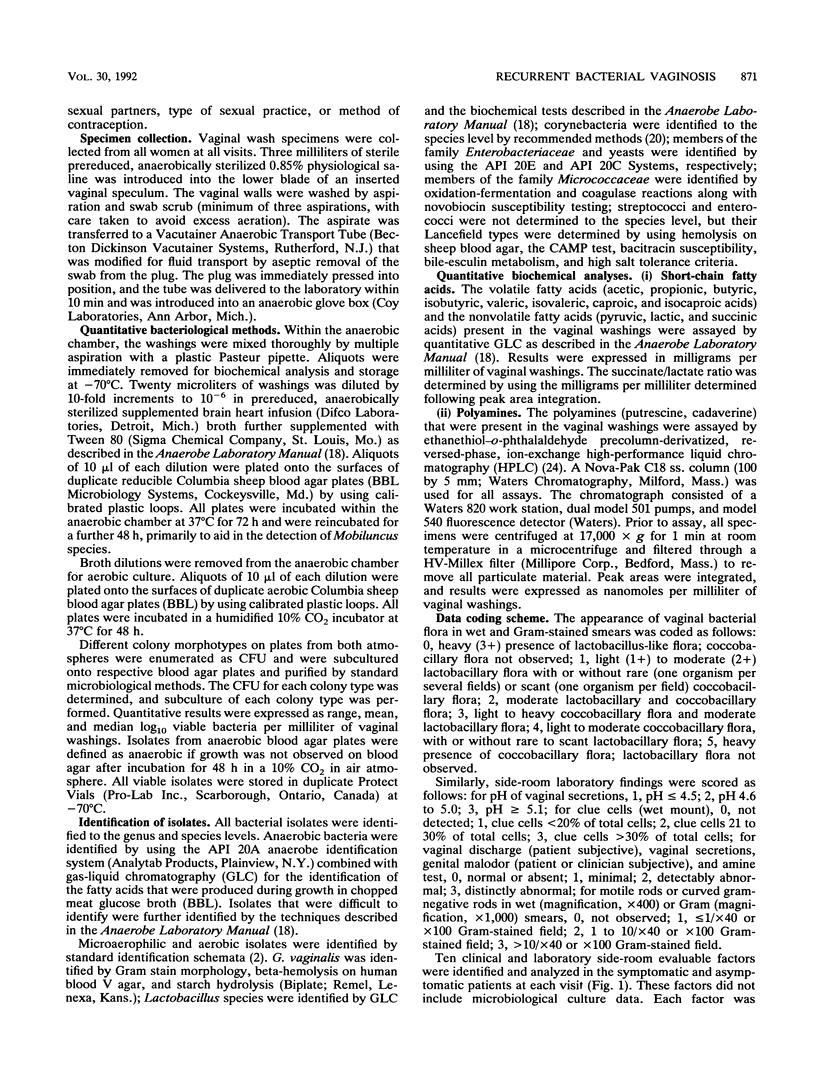
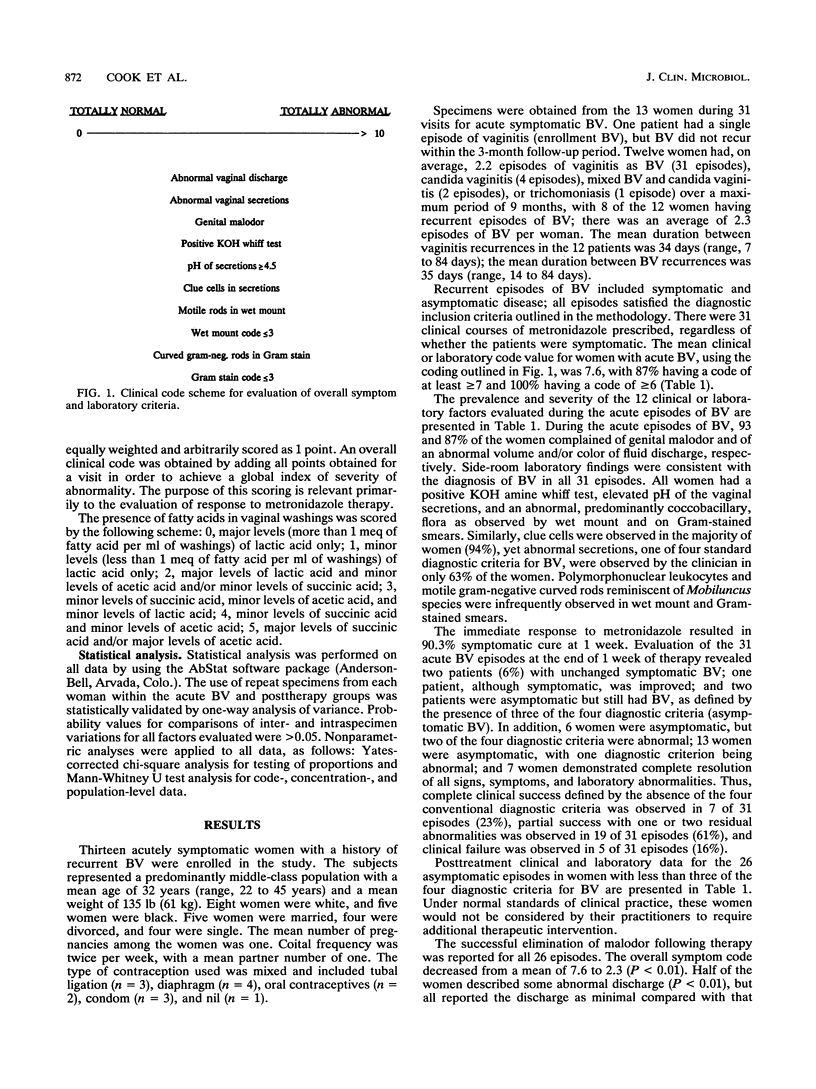
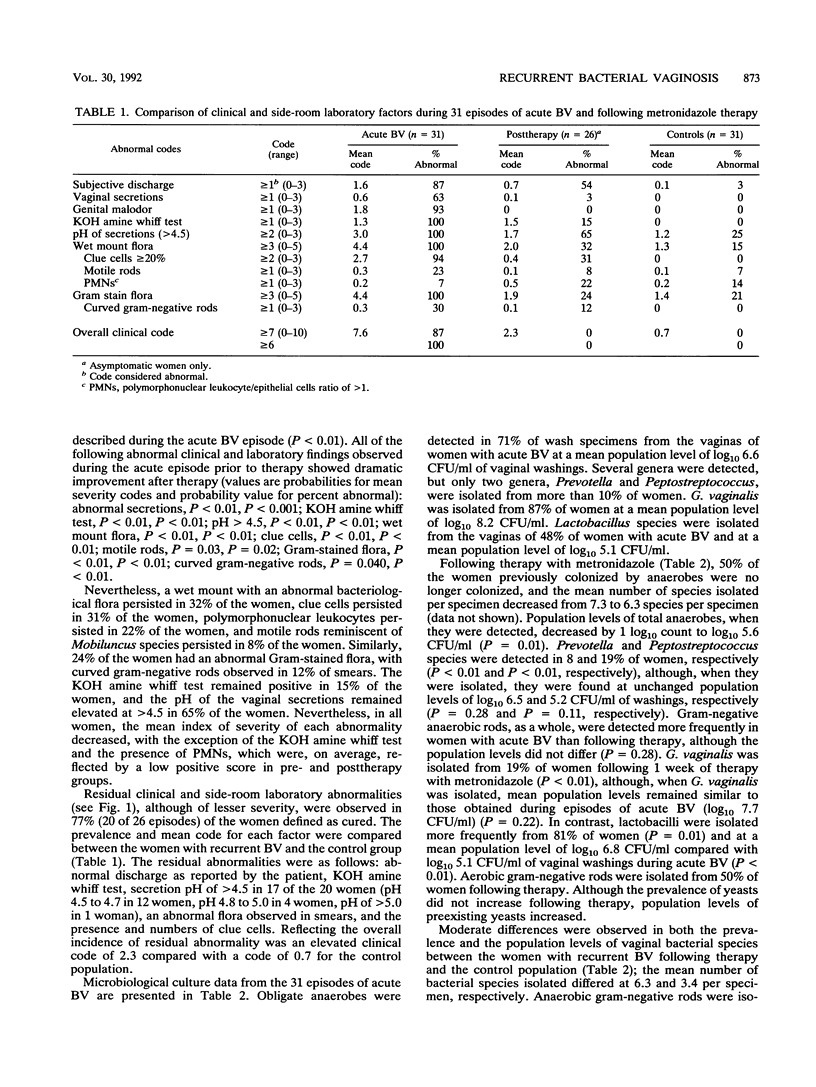
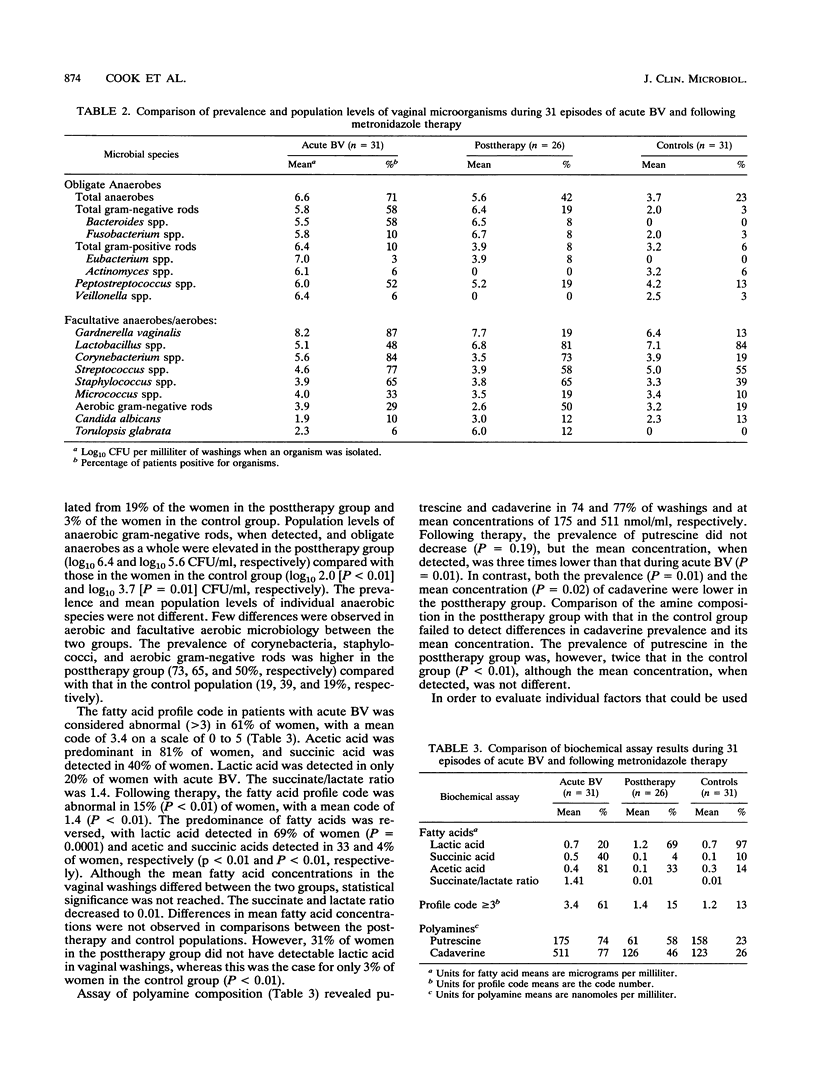
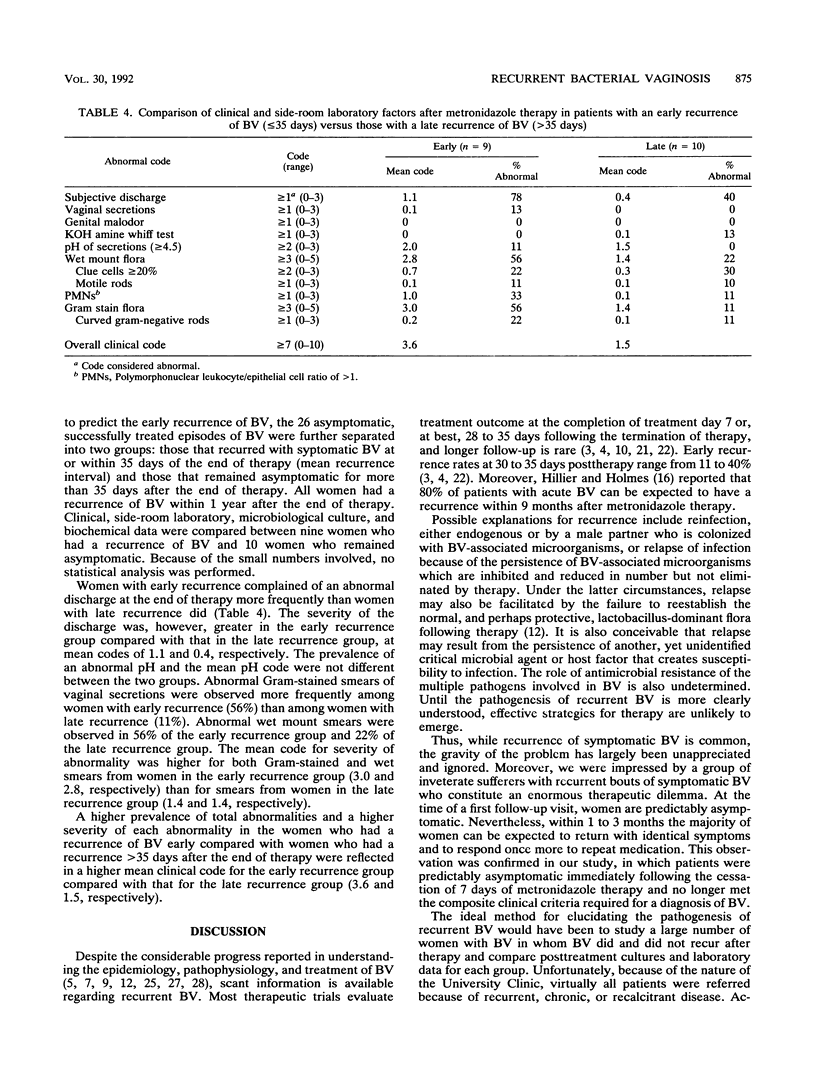
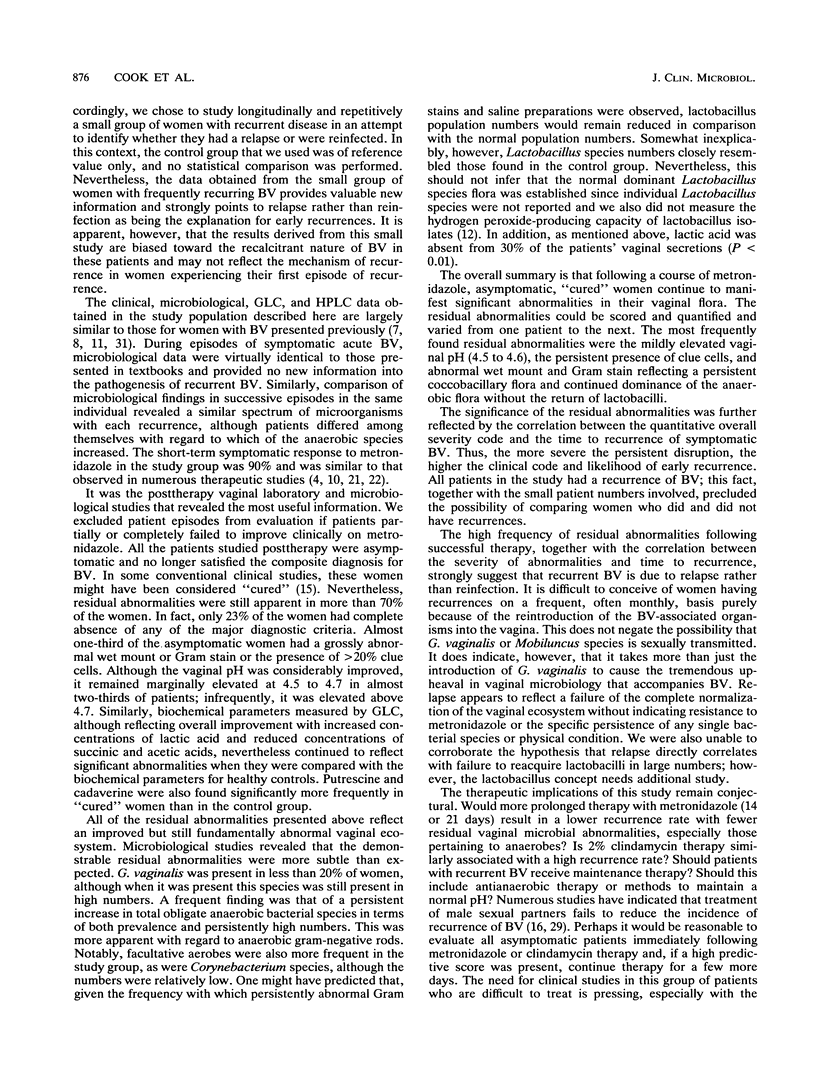

Selected References
These references are in PubMed. This may not be the complete list of references from this article.
- Amsel R., Totten P. A., Spiegel C. A., Chen K. C., Eschenbach D., Holmes K. K. Nonspecific vaginitis. Diagnostic criteria and microbial and epidemiologic associations. Am J Med. 1983 Jan;74(1):14–22. doi: 10.1016/0002-9343(83)91112-9. [DOI] [PubMed] [Google Scholar]
- Balsdon M. J., Taylor G. E., Pead L., Maskell R. Corynebacterium vaginale and vaginitis: a controlled trial of treatment. Lancet. 1980 Mar 8;1(8167):501–503. doi: 10.1016/s0140-6736(80)92762-2. [DOI] [PubMed] [Google Scholar]
- Brand J. M., Galask R. P. Trimethylamine: the substance mainly responsible for the fishy odor often associated with bacterial vaginosis. Obstet Gynecol. 1986 Nov;68(5):682–685. [PubMed] [Google Scholar]
- Chen K. C., Amsel R., Eschenbach D. A., Holmes K. K. Biochemical diagnosis of vaginitis: determination of diamines in vaginal fluid. J Infect Dis. 1982 Mar;145(3):337–345. doi: 10.1093/infdis/145.3.337. [DOI] [PubMed] [Google Scholar]
- Chen K. C., Forsyth P. S., Buchanan T. M., Holmes K. K. Amine content of vaginal fluid from untreated and treated patients with nonspecific vaginitis. J Clin Invest. 1979 May;63(5):828–835. doi: 10.1172/JCI109382. [DOI] [PMC free article] [PubMed] [Google Scholar]
- Clouds over galactosaemia. Lancet. 1982 Dec 18;2(8312):1379–1380. [PubMed] [Google Scholar]
- Cook R. L., Reid G., Pond D. G., Schmitt C. A., Sobel J. D. Clue cells in bacterial vaginosis: immunofluorescent identification of the adherent gram-negative bacteria as Gardnerella vaginalis. J Infect Dis. 1989 Sep;160(3):490–496. doi: 10.1093/infdis/160.3.490. [DOI] [PubMed] [Google Scholar]
- Eschenbach D. A., Critchlow C. W., Watkins H., Smith K., Spiegel C. A., Chen K. C., Holmes K. K. A dose-duration study of metronidazole for the treatment of nonspecific vaginosis. Scand J Infect Dis Suppl. 1983;40:73–80. [PubMed] [Google Scholar]
- Eschenbach D. A., Davick P. R., Williams B. L., Klebanoff S. J., Young-Smith K., Critchlow C. M., Holmes K. K. Prevalence of hydrogen peroxide-producing Lactobacillus species in normal women and women with bacterial vaginosis. J Clin Microbiol. 1989 Feb;27(2):251–256. doi: 10.1128/jcm.27.2.251-256.1989. [DOI] [PMC free article] [PubMed] [Google Scholar]
- Eschenbach D. A., Hillier S., Critchlow C., Stevens C., DeRouen T., Holmes K. K. Diagnosis and clinical manifestations of bacterial vaginosis. Am J Obstet Gynecol. 1988 Apr;158(4):819–828. doi: 10.1016/0002-9378(88)90078-6. [DOI] [PubMed] [Google Scholar]
- Fredricsson B., Hagström B., Evaldson G., Nord C. E. Gardnerella-associated vaginitis and anaerobic bacteria. Gynecol Obstet Invest. 1984;17(5):236–241. doi: 10.1159/000299155. [DOI] [PubMed] [Google Scholar]
- Gravett M. G., Hummel D., Eschenbach D. A., Holmes K. K. Preterm labor associated with subclinical amniotic fluid infection and with bacterial vaginosis. Obstet Gynecol. 1986 Feb;67(2):229–237. doi: 10.1097/00006250-198602000-00013. [DOI] [PubMed] [Google Scholar]
- Greaves W. L., Chungafung J., Morris B., Haile A., Townsend J. L. Clindamycin versus metronidazole in the treatment of bacterial vaginosis. Obstet Gynecol. 1988 Nov;72(5):799–802. [PubMed] [Google Scholar]
- Hillier S. L., Martius J., Krohn M., Kiviat N., Holmes K. K., Eschenbach D. A. A case-control study of chorioamnionic infection and histologic chorioamnionitis in prematurity. N Engl J Med. 1988 Oct 13;319(15):972–978. doi: 10.1056/NEJM198810133191503. [DOI] [PubMed] [Google Scholar]
- Holst E., Wathne B., Hovelius B., Mårdh P. A. Bacterial vaginosis: microbiological and clinical findings. Eur J Clin Microbiol. 1987 Oct;6(5):536–541. doi: 10.1007/BF02014242. [DOI] [PubMed] [Google Scholar]
- Malouf M., Fortier M., Morin G., Dube J. L. Treatment of Hemophilus vaginalis vaginitis. Obstet Gynecol. 1981 Jun;57(6):711–714. [PubMed] [Google Scholar]
- Pheifer T. A., Forsyth P. S., Durfee M. A., Pollock H. M., Holmes K. K. Nonspecific vaginitis: role of Haemophilus vaginalis and treatment with metronidazole. N Engl J Med. 1978 Jun 29;298(26):1429–1434. doi: 10.1056/NEJM197806292982601. [DOI] [PubMed] [Google Scholar]
- Piot P., Van Dyck E., Godts P., Vanderheyden J. The vaginal microbial flora in non-specific vaginitis. Eur J Clin Microbiol. 1982 Oct;1(5):301–306. doi: 10.1007/BF02019976. [DOI] [PubMed] [Google Scholar]
- Sobel J. D. Bacterial vaginosis--an ecologic mystery. Ann Intern Med. 1989 Oct 1;111(7):551–553. doi: 10.7326/0003-4819-111-7-551. [DOI] [PubMed] [Google Scholar]
- Spiegel C. A., Amsel R., Eschenbach D., Schoenknecht F., Holmes K. K. Anaerobic bacteria in nonspecific vaginitis. N Engl J Med. 1980 Sep 11;303(11):601–607. doi: 10.1056/NEJM198009113031102. [DOI] [PubMed] [Google Scholar]
- Spiegel C. A., Davick P., Totten P. A., Chen K. C., Eschenbach D. A., Amsel R., Holmes K. K. Gardnerella vaginalis and anaerobic bacteria in the etiology of bacterial (nonspecific) vaginosis. Scand J Infect Dis Suppl. 1983;40:41–46. [PubMed] [Google Scholar]
- Spiegel C. A., Eschenbach D. A., Amsel R., Holmes K. K. Curved anaerobic bacteria in bacterial (nonspecific) vaginosis and their response to antimicrobial therapy. J Infect Dis. 1983 Nov;148(5):817–822. doi: 10.1093/infdis/148.5.817. [DOI] [PubMed] [Google Scholar]
- Swedberg J., Steiner J. F., Deiss F., Steiner S., Driggers D. A. Comparison of single-dose vs one-week course of metronidazole for symptomatic bacterial vaginosis. JAMA. 1985 Aug 23;254(8):1046–1049. [PubMed] [Google Scholar]
- Taylor E., Blackwell A. L., Barlow D., Phillips I. Gardnerella vaginalis, anaerobes, and vaginal discharge. Lancet. 1982 Jun 19;1(8286):1376–1379. doi: 10.1016/s0140-6736(82)92498-9. [DOI] [PubMed] [Google Scholar]
- Thomason J. L., Gelbart S. M., Anderson R. J., Walt A. K., Osypowski P. J., Broekhuizen F. F. Statistical evaluation of diagnostic criteria for bacterial vaginosis. Am J Obstet Gynecol. 1990 Jan;162(1):155–160. doi: 10.1016/0002-9378(90)90839-y. [DOI] [PubMed] [Google Scholar]


